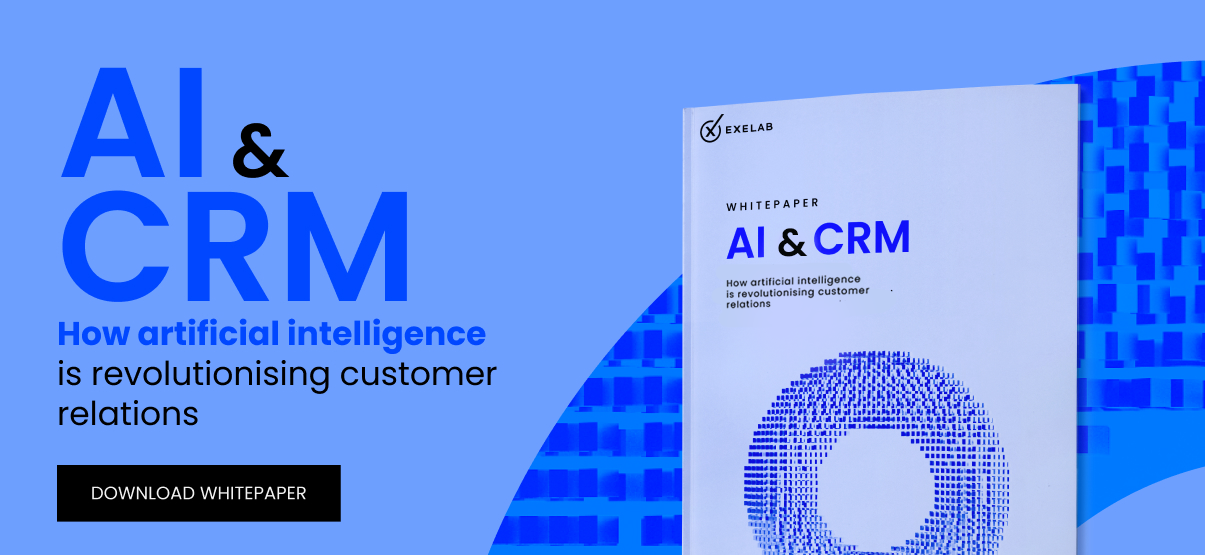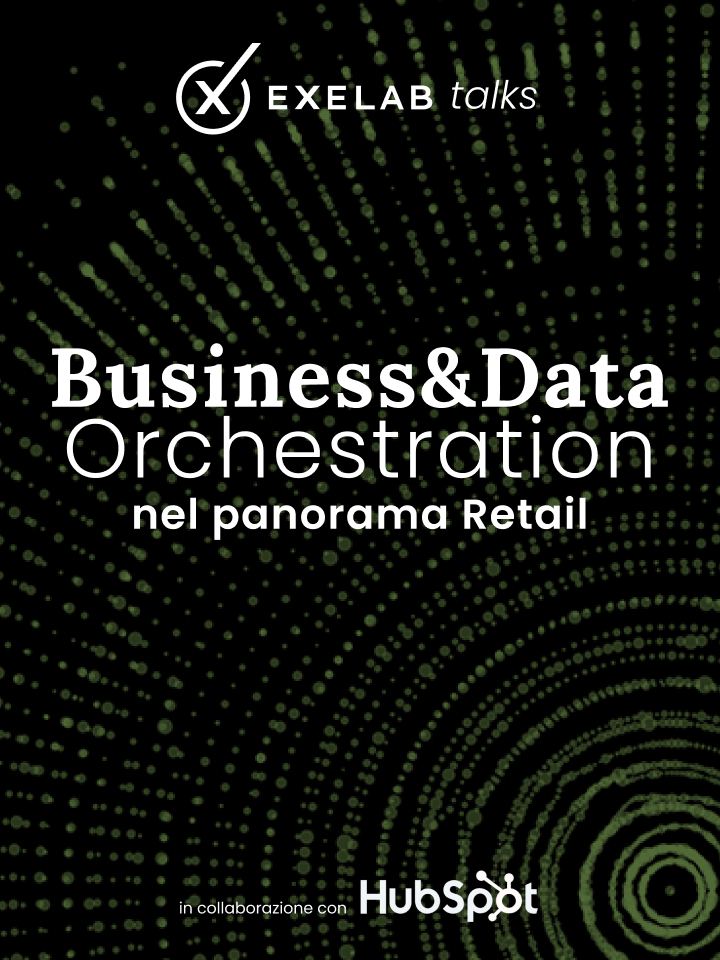
The Future of Loyalty in the Data Era
Increasingly sophisticated and personalized customer experiences...
Read moreInsights
Go to the BlogIn primo piano

The Future of Loyalty in the Data Era
Increasingly sophisticated and personalized customer experiences...
Read moreEnterprise Solutions
Recent Publications
Whitepaper

How artificial intelligence is revolutionising customer relations
Download the WhitepaperExtra
A new horizon for CRM
Automation and integration: apps

100% digital, fast and paper free processes
A new standard based on AI and HubSpot
Integrated and optimized e-commerce management with HubSpot
Exelab World
Where ideas and innovation meet
Texts to meet tomorrow's challenges
Discover our insights: visit the blog
Latest updates
Insights
Go to the BlogIn primo piano

The Future of Loyalty in the Data Era
Increasingly sophisticated and personalized customer experiences...
Read moreAbout Us
Innovation, excellence, technology: at Exelab we design the future of business processes
Exelab and The Client Group: an operational synergy to raise customer experience to the highest level
Careers
We are always looking for talent ready to make their mark: explore our opportunities
We're hiring!Exelab is an official partner of


Events
Discover our EventsMost Recent Event

Solutions
Enterprise Technology
HubSpot
Discover
About
Solutions

Exelab Solutions
Insights
Go to the BlogIn primo piano

The Future of Loyalty in the Data Era
Increasingly sophisticated and personalized customer experiences...
Read moreEnterprise Technology

Enterprise Solutions
Recent Publications
Whitepaper

How artificial intelligence is revolutionising customer relations
Download the WhitepaperHubSpot

Extra
A new horizon for CRM
Automation and integration: apps
Discover


100% digital, fast and paper free processes
A new standard based on AI and HubSpot
Integrated and optimized e-commerce management with HubSpot
Exelab World
Where ideas and innovation meet
Texts to meet tomorrow's challenges
Discover our insights: visit the blog
Latest updates
Insights
Go to the BlogIn primo piano

The Future of Loyalty in the Data Era
Increasingly sophisticated and personalized customer experiences...
Read moreAbout

About Us
Innovation, excellence, technology: at Exelab we design the future of business processes
Exelab and The Client Group: an operational synergy to raise customer experience to the highest level
Careers
We are always looking for talent ready to make their mark: explore our opportunities
We're hiring!Exelab is an official partner of


Events
Discover our EventsMost Recent Event

Companies that have implemented Business Personas have recorded conversion rates 10% higher.
We have transitioned from the homogeneity of traditional advertising, where TV spots and print inserts dictated the rules, to the "Big Data" era, which has completely redefined our perception of the customer. The advantage? Today, thanks to data and analytics, we can outline our customers' profiles with a precision unthinkable in the past.
In this sense, one of the most refined and effective tools in the arsenal of CMOs, strategists and creatives are business personas.
Business personas - or buyer personas - are vivid and detailed representations of hypothetical individuals, endowed with emotions, aspirations and desires. What are they for? They provide us with an indispensable guide in the creation of messages and strategies, making every communication more personal and focused. When we imagine talking to personas, in fact, we are naturally led to humanize our communications, adopt more client-centered strategies and test our services or products in a more credible and realistic way.
This is because simulating an interaction with fictitious entities - well defined on the insights of a real audience -, trains teams for the experience with real customers.
The result is a new efficiency in endless aspects of customer interaction (leads, sales, customer service, communication, etc.).
The creation of effective personas represents a delicate balance between art and science. Superficial information gathering is not enough; it is essential to conduct in-depth interviews, carefully collect data and closely observe purchasing behaviors. This data, once integrated with insights from centralized collection tools (such as CRM) and from different company teams, must flow into well-defined and representative customer profiles. But beware: like any effective tool, these personas must be periodically reviewed and updated based on new feedback and latest market trends, or our industry's.
Investing in the accuracy and authenticity of Business Personas always pays off, indeed, for many companies it is increasingly the first key to successful product or service campaigns and launches.
Over the course of this article we will further explore:
71% of companies that have met revenue goals have well defined their Business Personas.
Business Personas are, in practice, "avatars" of our ideal customers. These representations help us better understand who our customers are and what they want, allowing us to adapt content and interactions to their needs and preferences. Although the concept of personas is not new, it is becoming increasingly important in a world where customers want more and more tailored content.
But let's take a closer look: what really makes a Business Persona special?
Audience Representation: It works as a mirror of a specific segment of our audience, providing a clear picture of what it seeks, desires, and values important.
Multidisciplinary Tool: Initially used in design and UX processes, today Business Personas are fundamental in many other marketing processes, especially in online campaigns.
Constantly Updated and Predictive: A Business Persona is not a fixed profile. It evolves with data and projections - such as customer feedback or purchasing behaviors - predicting new directions.
Guides Our Choices: It helps us make informed decisions, ensuring that what we do is relevant and useful for our audience.
Business Personas determine an increase in interactions with company websites from 2 to 5 times.
Creating an effective Persona is not simply about imagining an ideal customer. It is an operation that requires method, research and deep intuition. Effective Personas are in fact the result of a balanced mix between quantitative analysis and human understanding. Here's how to proceed:
Clarity of the offer: in a preliminary phase, before identifying who might be interested in our product or service, we need to thoroughly understand the added value of what we are offering. What is its strength? Who is it really aimed at?
Preliminary Questions: at this point, the first concrete step is to define your persona, by asking specific questions about the ideal customer:
What is their profession?
How does a typical day go by?
Where do they look for information?
How do they prefer to obtain products and services?
What are they looking for in a supplier?
What are their goals?
Guiding Questions: now that we have defined some basic coordinates, it is time to imagine sitting down with our personas and interviewing them. What questions would we ask? In addition to the classics, consider:
Collection of Concrete Data: Throughout the process, we avoid relying solely on assumptions. Let's use all the information resources at our disposal:
CRM: What trends emerge from the data of our current customers?
Surveys and Questionnaires: We look for direct feedback on what customers appreciate or want to improve.
Analysis of Purchasing Behaviors: What are the most requested products or services? Are there recurring purchasing patterns?
Feedback from Customer Service: What questions or concerns arise frequently?
Segmentation and Customization: One Business Persona is not enough. We must consider the variety of our customer base. Let's develop different Business Personas that represent different demographics, behaviors and needs.
Periodic Review and Update: Since the market and customer needs evolve, our Business Personas need to be updated as well. It is essential to review and adjust the profiles based on new information and perceptions.
Let's always remember that an effective Business Persona is not just a list of demographic data. It is a detailed and dynamic description that helps us better understand our customers, anticipate their needs and adjust our strategies accordingly.
There are also several tools that allow you to accurately outline the motivations and challenges of our ideal customers and easily share this information with the entire company team.
Google Slides: offers editable persona templates to customize the slide layout with our Business Personas information.
PowerPoint: similar to Google Slides, this resource also allows you to customize the "persona" slides. We can save them with a new name and modify according to the needs of our company.
HubSpot's Persona Generator: is a powerful and free tool that allows you to easily create Business Personas. By answering strategic questions, we can generate a detailed document on our ideal customers, which can be downloaded in Word format and modified according to our needs. HubSpot not only provides us with a professional structure to map each persona, but also allows us to emphasize the specifics that make our target market unique.
SemRush Persona: another effective tool that offers the possibility to use preset templates or create new ones. We can add custom fields, share and download personas extremely easily. Managing and archiving information is simple and allows fluid exporting both to the cloud and desktop.
A persona-based strategy increases the CTR of personalized emails by 14%.
Everyone, from the sales team to marketing, from customer support to product development, benefits from better understanding who our customers are. Thanks to this clarity, we are able to identify the challenges to be addressed, make informed decisions on how to attract and support customers, and determine effective strategies in terms of content, product design and communication techniques.
Key Points to Consider:
Creating a Business Persona provides customer insights that we otherwise would not have had. Once defined, it is essential to share it with marketing, sales and customer service teams, ensuring that the entire organization has a consistent view of the ideal customer.
Personas, often called "marketing personas", are fundamental tools for the marketing team. These profiles allow to:
Knowing your customer is critical, especially during the sales phase. Using personas allows you to:
After making a sale, the relationship with the customer does not stop. What often retains the customer is post-sale interactions. Involving the service team in creating the personas prepares them to provide customized customer service tailored to each persona. Through this person-centered approach, the service team can:

In the B2B context, personas are particularly crucial since purchase decisions often involve multiple stakeholders within an organization. These personas help companies understand the different needs, challenges and key growth drivers. Here are some profile examples:
Decision Makers: Those who have final authority on purchasing decisions.
Influencers: Figures who may not have final decision-making power, but strongly influence decisions through their recommendations.
Users: Those who will actually use the product or service purchased.
Gatekeepers: Key roles that control access to information or resources.
Decision Maker - CEO: Carla, 45, is the CEO of a medium-sized company. She is always looking for innovative solutions that can increase efficiency and growth. She wants decisions to be based on solid, reliable data and prefers concise, direct communications.
Influencer - Manager Marco: Marco, 35, is a manager of a key department. Although he does not directly decide on purchases, his opinions are highly respected. Marco does a lot of research before recommending a product or service and places great importance on after-sales support.
User - Technician Tania: Tania, 28, is a technician who will actually use the purchased tools or services. She looks for user-friendly solutions and greatly values training and assistance. She is active on professional forums and values other users' reviews.
Gatekeeper - Administrator: Andrea, 40, is responsible for procurement. He controls the budget and ensures resources are used optimally. He prefers transparent suppliers, with clear contract terms and conditions and a solid reputation in the market.
Personas can also be leveraged in the context of market analysis and presentations to convey "complex pictures" through quick personifications that go beyond simple clustering. In other words, personas allow us to humanize and synthesize even non-linear market scenarios.
A good example is provided by Deloitte in the report "Success personified in the Fourth Industrial Revolution": the study examines business leaders' reactions to the challenges presented by the Fourth Industrial Revolution, focusing on four pillars: social impact, strategy, technology and talent management.
From this analysis, four "leadership archetypes" emerge, representing leader figures who are excelling in confronting Industry 4.0 challenges in these specific areas. The aim of the research is to understand the peculiarities and methodologies that make these leaders particularly effective.
The leadership archetypes identified are:
Social Supers: - They see social initiatives as essential to their business, creating value through solutions with positive socio-environmental impact. Their decision making is well structured and they are inclined to explore innovative technologies.
Data-Driven Decisives: They leverage an analytical approach in business strategies, basing their decisions on data analysis. They have a strong interest in innovative technologies and continuous team training.
Disruption Pioneers: They have excelled in adopting and implementing innovative technologies. Their decision-making strategy is comprehensive and they are actively engaged in staff training.
Talent Champions: They are pioneers in preparing their teams for future challenges, with a strong focus on ethics and value creation through social initiatives. They invest heavily in the training and growth of their employees.
These four archetypes, despite their specificities, have common features such as a future-oriented vision, participatory decision-making, and a strong emphasis on ethics and talent enhancement. Additionally, they have the merit of conveying complex market scenarios through simple clusters.
We have explored the essential role of Business Personas in corporate strategy. These profiles are not just representations of our ideal customers, but real tools that allow us to communicate, sell and assist more effectively.
However, merely defining a persona is not enough. To maximize the benefits offered by personas, it is essential to:
Looking to the future, personas will play an increasingly central role in defining personalized experiences for the customer. Thanks to advances in data analytics and artificial intelligence, it will be possible to outline ever more sophisticated and dynamic profiles. AI will allow processing enormous amounts of information in real time to identify customer-related patterns and trends. In addition, technologies like machine learning will continuously refine personas based on collected data, ensuring maximum accuracy and effectiveness.
In an extremely rapidly evolving competitive scenario, having a deep understanding of one's customers is no longer an advantage, but an essential necessity. Investing in the development of solid business personas, constantly updated thanks to AI, will be fundamental to creating distinctive experiences and value relationships with the customer. The companies that will be able to leverage this opportunity will be able to markedly differentiate themselves from competitors.
